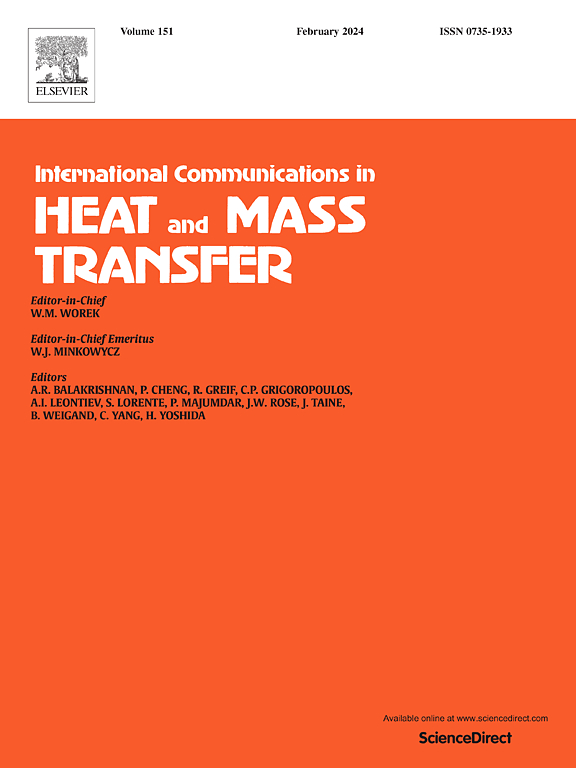蒸腾冷却结构失效模式及失效机理的研究进展
IF 6.4
2区 工程技术
Q1 MECHANICS
International Communications in Heat and Mass Transfer
Pub Date : 2025-07-23
DOI:10.1016/j.icheatmasstransfer.2025.109399
引用次数: 0
摘要
随着飞行速度的提高,高速飞行器在大气中飞行时要承受巨大的热负荷,传统的被动冷却技术无法满足要求。蒸腾冷却作为一种高效的主动冷却技术,提供了高达103-105W/cm2的冷却能力,与其他主动冷却方法相比,具有明显的优势:与对流冷却相比,它减少了大约2/3的冷却剂消耗,在同等冷却剂注入比下,它的冷却效率比再生冷却高35%,相对于对流冷却系统,它的结构重量减少了8.6%。此外,该技术还具有显著的形状适应性。然而,尽管该技术具有潜力,但在技术应用中仍面临一些故障问题,这阻碍了其在高速车辆上的应用。本文综述了高速车辆蒸腾冷却结构的失效模式和失效机理。根据材料的内在特性、孔隙结构的均匀性、冷却剂的独特特性、高速车辆的外部因素和冷却剂供应方式五个方面对失效模式进行了分类和总结。针对这些失效模式,本文进一步分析了每种失效模式的潜在原因,并展望了未来失效问题的研究趋势。虽然蒸腾冷却技术在高速车辆的热保护方面具有巨大的潜力,但克服这些挑战仍然是提高其效率和确保可靠性能的关键。本文章由计算机程序翻译,如有差异,请以英文原文为准。
Research progress on the failure modes and failure mechanisms of the transpiration cooling structure
As the speed of flight increases, high-speed vehicles experience enormous thermal loads when flying through the atmosphere, rendering traditional passive cooling techniques insufficient. Transpiration cooling, as an efficient active cooling technology, offers a cooling capacity of up to 103-105W/cm2, with demonstrated advantages over other active cooling methods: it reduces coolant consumption by approximately 2/3 compared to convection cooling, achieves 35% higher cooling efficiency than regenerative cooling at equivalent coolant injection ratios, and reduces structural weight by 8.6% relative to convection cooling systems. Furthermore, the technology demonstrates remarkable shape adaptability. However, despite its potential, the technology still faces several failure issues in technical applications, which hinder its use on high-speed vehicles. This paper provides a comprehensive review of the failure modes and failure mechanisms of transpiration cooling structures in high-speed vehicles. The failure modes are classified and summarized according to five aspects: the intrinsic properties of materials, pore structure uniformity, unique properties of the coolant, external factors of high-speed vehicles, and coolant supply methods. Regarding these failure modes, this paper further analyzes the underlying causes of each failure mode and prospects future research trends on failure issues. While transpiration cooling technology holds great potential for the thermal protection of high-speed vehicles, overcoming these challenges remain essential to improving its efficiency and ensuring reliable performance.
求助全文
通过发布文献求助,成功后即可免费获取论文全文。
去求助
来源期刊
CiteScore
11.00
自引率
10.00%
发文量
648
审稿时长
32 days
期刊介绍:
International Communications in Heat and Mass Transfer serves as a world forum for the rapid dissemination of new ideas, new measurement techniques, preliminary findings of ongoing investigations, discussions, and criticisms in the field of heat and mass transfer. Two types of manuscript will be considered for publication: communications (short reports of new work or discussions of work which has already been published) and summaries (abstracts of reports, theses or manuscripts which are too long for publication in full). Together with its companion publication, International Journal of Heat and Mass Transfer, with which it shares the same Board of Editors, this journal is read by research workers and engineers throughout the world.

 求助内容:
求助内容: 应助结果提醒方式:
应助结果提醒方式:


